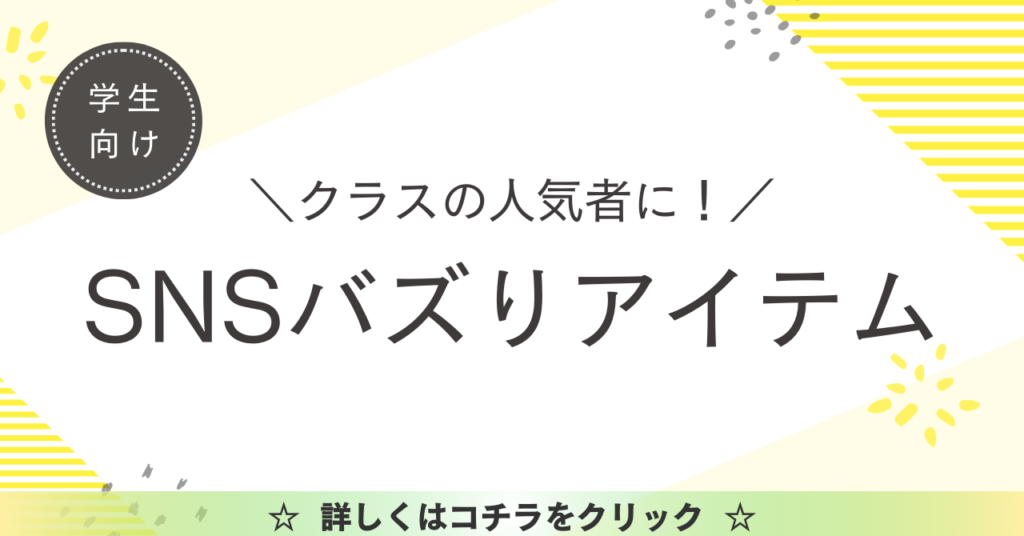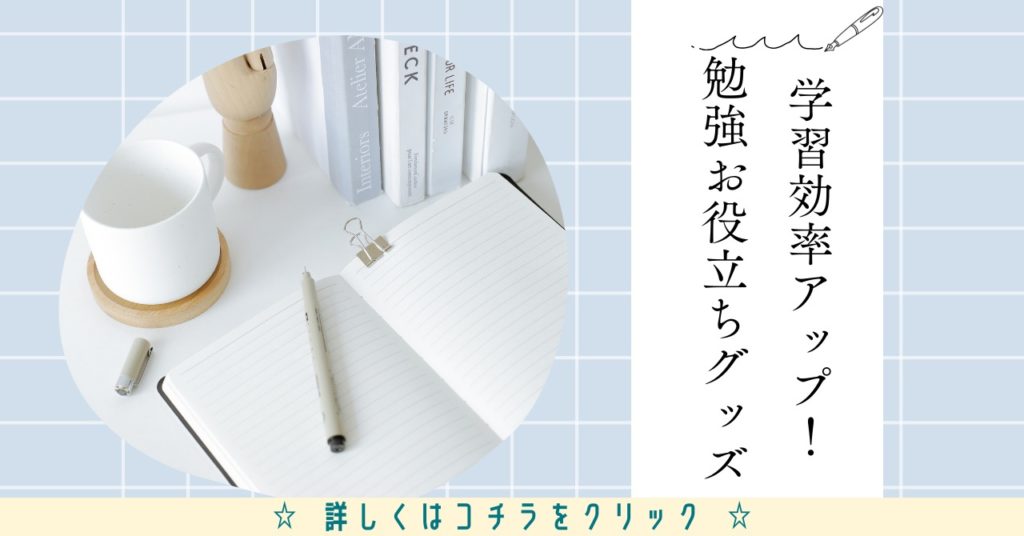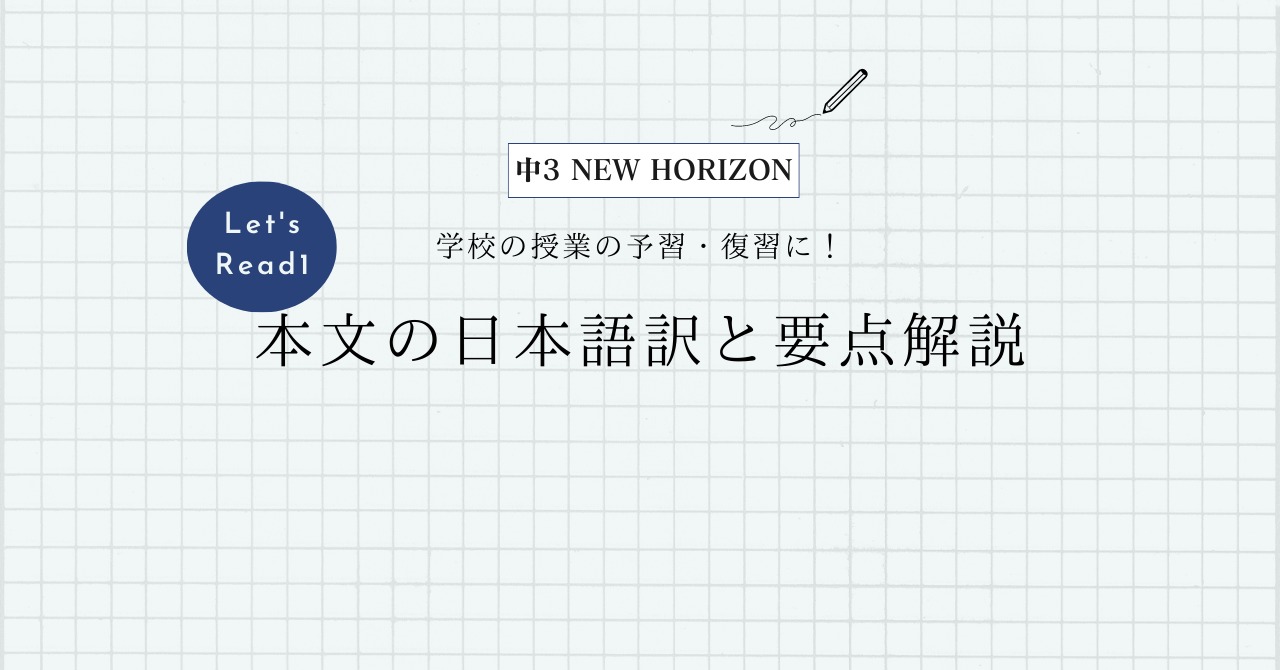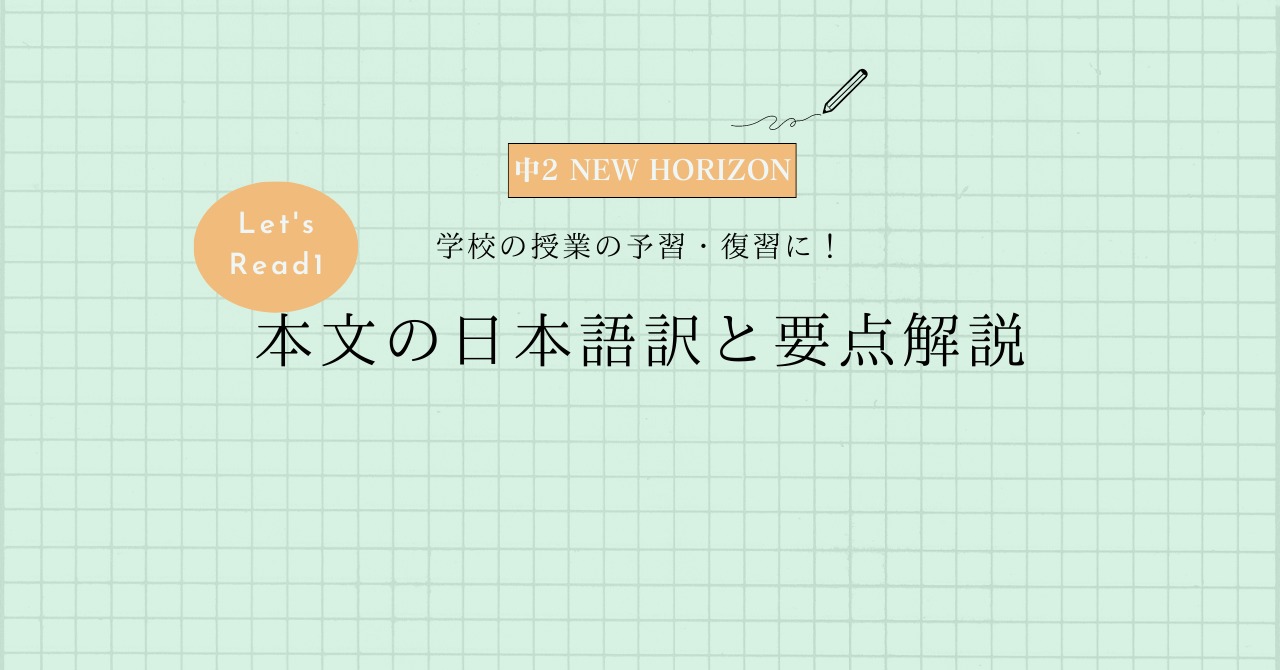東京書籍 中学3年生 NEW HORIZON(ニューホライズン) Let’s Read2の本文の日本語訳と重要箇所の解説です。
Let’s Read1の解説はこちらからご覧ください。
>中3NEW HORIZON Let’s Read1 本文和訳
- Let’s Read2 本文と日本語訳
- Let’s Read2 重要事項の解説
- What does “power” in this title mean? -It means supply energy.
- If the electricity were cut for one week, what would happen to our lives?
- The lights would be off.
- Trains would stop.
- We could not charge our smartphones.
- We depend on electricity to power most of our daily activities.
- How can we make the electricity we need for our future?
- Japan uses a lot of oil, coal, and natural gas to make electricity.
- These resources are called “fossil fuels.”
- They are relatively cheap, and they can be used for many things.
- However, scientists say that we may run out of fossil fuels in 100 years.
- There are other problems, too.
- Fossil fuels release carbon dioxide and other dangerous chemicals.
- They increase global warming and damage our health.
- Japan also makes electricity from nuclear power.
- Nuclear power produces a large amount of energy without releasing carbon dioxide.
- However, it is difficult to control radiation and handle nuclear waste safely all the time.
- Now, many countries are using sunshine, wind, steam, rivers, and even ocean waves to make electricity.
- These are examples of “renewable energy.”
- Japan has many rivers, and their power is used to produce electricity.
- However, we need dams to use water power, and these dams can damage the environment.
- Research in other renewable energy technologies is progressing.
- Already, Denmark gets forty percent of its electricity from wind power.
- One quarter of the electricity used in Iceland comes from the natural heat in the ground.
- People around the world are working to solve our energy problems.
- Reyhan Jamalova is one of those people.
- When she was fifteen, Reyhan invented a device to make electricity from rain.
- Reyhan’s device can power 22 LED lamps for 50 seconds.
- Each device uses only 7 liters of rainwater.
- Its battery can store power to use later.
- Reyhan says she created the device to help poor people, especially in rainy countries.
- It does not even need power lines.
- It can help many people get electricity.
- Is there anything you can do for a sustainable energy future?
- As a consumer, you can decide how much electricity you use.
- You can also decide what kind of energy you want to use.
- You may even be an inventor, like Reyhan.
- What can you do to make your energy future brighter.
- Let’s Read2 まとめ
Let’s Read2 本文と日本語訳
What does “power” in this title mean?
「このタイトルの”power”とは何を意味していますか?」
It means supply energy.
「それはエネルギーの供給を意味しています。」
If the electricity were cut for one week, what would happen to our lives?
「もし電気が1週間止められたら,私たちの生活に何が起こるでしょうか?」
The lights would be off.
「光が消えるでしょう。」
Trains would stop.
「電車が止まるでしょう。」
We could not charge our smartphones.
「私たちはスマートフォンを充電できないでしょう。」
We depend on electricity to power most of our daily activities.
「私たちはほとんどの日常の活動を行うために,電気に頼っています。」
How can we make the electricity we need for our future?
「どのようにして私たちの将来のために必要な電気を作ることができるのでしょうか?」
Japan uses a lot of oil, coal, and natural gas to make electricity.
「日本は電気を作るためにたくさんの石油,石炭,天然ガスを使っています。」
These resources are called “fossil fuels.”
「これらの資源は『化石燃料』と呼ばれています。」
Fossil fuels have some good points.
「化石燃料にはいくつかの良い点があります。」
They are relatively cheap, and they can be used for many things.
「それらは比較的安く,そして多くのことに使えます。」
However, scientists say that we may run out of fossil fuels in 100 years.
「しかし,科学者は100年後には私たちは化石燃料を使い果たすかもしれないと言っています。」
There are other problems, too.
「他の問題もあります。」
Fossil fuels release carbon dioxide and other dangerous chemicals.
「化石燃料は二酸化炭素と他の危険な化学物質を排出します。」
They increase global warming and damage our health.
「それらは地球温暖化を促進させ,私たちの健康に害を与えます。」
Q1. What do we depend on to power our daily activities?
「日常の活動を行うために,私たちは何に頼っていますか?」
A1. We depend on electricity.
「私たちは電気に頼っています。」
Q2. What do fossil fuels release?
「化石燃料は何を排出しますか?」
A2. They release carbon dioxide and other dangerous chemicals.
「それらは二酸化炭素と他の危険な化学物質を排出します。」
Japan also makes electricity from nuclear power.
「日本は原子力発電からも電気を作っています。」
Nuclear power produces a large amount of energy without releasing carbon dioxide.
「原子力発電は二酸化炭素を排出せずに巨大なエネルギーを生成します。」
However, it is difficult to control radiation and handle nuclear waste safely all the time.
「しかし,放射能を制御して,常に核廃棄物を安全に扱うのは難しいです。」
Now, many countries are using sunshine, wind, steam, rivers, and even ocean waves to make electricity.
「今,多くの国は電気を作るために太陽光,風,蒸気,川,そして海の波さえも使っています。」
These are examples of “renewable energy.”
「これらは『再生可能エネルギー』の例です。」
Japan has many rivers, and their power is used to produce electricity.
「日本にはたくさんの川があり,その力は電気を生成するために使われています。」
Their water is renewable and does not release dangerous chemicals.
「川の水は再生可能で,危険な化学物質を排出しません。」
However, we need dams to use water power, and these dams can damage the environment.
「しかし,水の力を使うためにはダムが必要で,ダムは環境に害を与える可能性があります。」
Research in other renewable energy technologies is progressing.
「他の再生可能エネルギー技術の研究が進んでいます。」
Already, Denmark gets forty percent of its electricity from wind power.
「すでに,デンマークは風力から電気の40%を得ています。」
One quarter of the electricity used in Iceland comes from the natural heat in the ground.
「アイスランドで使われる電気の4分の1は自然の地熱からできています。」
People around the world are working to solve our energy problems.
「世界中の人々がエネルギー問題を解決するために働いています。」
Q3. When nuclear power produces energy, does it release carbon dioxide?
「原子力発電がエネルギーを生成するとき,二酸化炭素を排出しますか?」
A3. No, it doesn’t.
「いいえ,排出しません。」
Q4. What are examples of “renewable energy”?
「『再生可能エネルギー』の例は何がありますか?」
A4. They are sunshine, wind, steam, rivers, and ocean waves.
「太陽光,風,蒸気,川,海の波です。」
Q5. What do Denmark and Iceland use to get their electricity?
「デンマークとアイスランドは電気を得るために何を使いますか?」
A5. Denmark uses wind power and Iceland uses the natural heat in the ground.
「デンマークは風力を使い,アイスランドは地熱を使います。」
Reyhan Jamalova is one of those people.
「レイハン・ジャマロバさんはそういった人の1人です。」
Reyhan is a student in Azerbaijan.
「レイハンさんはアゼルバイジャンの学生です。」
When she was fifteen, Reyhan invented a device to make electricity from rain.
「レイハンさんが15歳の時,雨から電気を作る装置を発明しました。」
Reyhan’s device can power 22 LED lamps for 50 seconds.
「レイハンさんの装置は,50秒間で22個のLEDランプに電気を共有できます。」
Each device uses only 7 liters of rainwater.
「それぞれの装置は7リットルの雨水しか使いません。」
Its battery can store power to use later.
「そのバッテリーは後で使う動力を溜めることができます。」
Reyhan says she created the device to help poor people, especially in rainy countries.
「レイハンさんは,特に雨の多い国の貧しい人々を助けるために装置を創ったと言っています。」
It does not even need power lines.
「それは電線さえ必要ありません。」
It can help many people get electricity.
「多くの人が電気を得るのを助けることができます。」
Is there anything you can do for a sustainable energy future?
「持続可能なエネルギーの将来のためにあなたができることは何かあるでしょうか?」
As a consumer, you can decide how much electricity you use.
「消費者として,どれくらいの電気を使うかを決めることができます。」
You can also decide what kind of energy you want to use.
「また,どんな種類のエネルギーを使いたいかも決めることができます。」
You may even be an inventor, like Reyhan.
「あなたはレイハンさんのような発明家になることさえあるかもしれません。」
Your actions are important.
「あなたの行動が重要なのです。」
What can you do to make your energy future brighter.
「エネルギーの将来をより明るくするために何ができるでしょうか?」
Q6. What did Reyhan invent?
「レイハンさんは何を発明しましたか?」
A6. She invented a device to make electricity from rain.
「雨から電気を作る装置を発明しました。」
Q7. What can we decide as consumers?
「消費者として私たちは何を決めることができますか?」
A7. We can decide how much electricity we use and what kind of energy we want to use.
「どれくらいの電気を使うかと,どんな種類のエネルギーを使いたいかを決めることができます。」

Let’s Read2 重要事項の解説
What does “power” in this title mean? -It means supply energy.
“power”は「力」,“title”は「タイトル,題名」という名詞ですね。
“mean”は「を意味する」という動詞です。
“supply”は「供給」,“energy”は「エネルギー」という名詞ですね。“energy”の発音は「エナジー」なので,「エネルギー」と読まないように気を付けましょう!
If the electricity were cut for one week, what would happen to our lives?
この文では「仮定法過去」が使われていますね。
“electricity”は「電気」という名詞です。
“cut”は「を切る」で,ここでは「受動態」で使われています。“happen”は「起こる」という動詞で,“happen to~”で「~に起こる,発生する」という意味です。
“lives”は“life(生活,人生)“の複数形で,語尾が”f,fe”で終わる名詞を複数形にするときは”f,fe”を取って”ves”をつけます。
knife→knives(ナイフ), leaf→leaves(葉)などがあります。
The lights would be off.
この文も前の文から続いていて,“if”はないですが「仮定法過去」になっています。
“light”は「光」という名詞で,“off”は「(スイッチなどが)切れて」という副詞です。
Trains would stop.
この文も前の文から続いていて,“if”はないですが「仮定法過去」になっています。
We could not charge our smartphones.
この文も前の文から続いていて,“if”はないですが「仮定法過去」になっています。
“charge”は「を充電する」という動詞です。
We depend on electricity to power most of our daily activities.
“depend on~”は「~に頼る,依存する」という重要表現になります。
ここの“power”は「に動力を供給する」という動詞ですが,今回は「を行う」としました。
また,“to power”は「不定詞の副詞的用法」ですね。
“most of~”は「ほとんどの~」という意味で,“daily”は「日々の,日常の」という形容詞,“activity”は「活動」という名詞になります。
How can we make the electricity we need for our future?
ここでは「目的格の関係代名詞」が使われていますね。
“we need for our future”が先行詞“the electricity”を修飾しています。関係代名詞”that/which”は省略されていますね。
“need”は「を必要とする」という動詞で,“future”は「未来,将来」という名詞です。
Japan uses a lot of oil, coal, and natural gas to make electricity.
“oil”は「石油」,“coal”は「石炭」,“natural gas”は「天然ガス」という名詞です。
“natural”は「自然の」という形容詞になります。
また,“to make”は「不定詞の副詞的用法」ですね。
These resources are called “fossil fuels.”
この文では「受動態」が使われていますね。
“these”は“this”の複数形で,「これらは,これらの」という意味です。
“resource”は「資源」,“fossil fuel”は「化石燃料」という名詞になります。
They are relatively cheap, and they can be used for many things.
“They”は“fossil fuels”を指しています。
“relatively”は「比較的」という副詞で,“cheap”は「安い」という形容詞になります。
後半は「受動態」が使われていますね。“thing”は「もの,こと」という名詞です。
However, scientists say that we may run out of fossil fuels in 100 years.
“however”は「しかし」という意味の副詞になります。
同じ意味で“but”がありますが,こちらは接続詞なので品詞が異なります。“but”は“文A,but 文B”というように,2つの文を繋ぐ際に使います。
“文A. But 文B.”というように,“but”を文の先頭に置いて1文だけで完結させるのは原則NGとなります。
“scientist”は「科学者」という名詞で,さらにこの文では「接続詞that」が使われていますね。
“may”は「~かもしれない」という助動詞で,“run out of~”は「を使い果たす」という意味になります。
“in 数字”は「~後に」という表現です。今回は「100年後に」となりますね。
There are other problems, too.
この文では「there構文」が使われていますね。
“other”は「他の」という形容詞で,“problem”は「問題」という名詞です。
Fossil fuels release carbon dioxide and other dangerous chemicals.
“release”は「を放出する,排出する,解放する」という動詞です。
“carbon dioxide”は「二酸化炭素」,“chemical”は「化学物質」という名詞ですね。
“dangerous”は「危険な」という形容詞です。
They increase global warming and damage our health.
“They”は“fossil fuels”を指しています。
“increase”は「を増やす」,“damage”は「に害を与える」という動詞ですね。
“global warming”は「地球温暖化」,“health”は「健康」という名詞です。
Japan also makes electricity from nuclear power.
“also”は「また,さらに」といった副詞で,付け加える役割があります。色々な文で使うので必ず覚えましょう!
“nuclear power”は「原子力発電」です。
Nuclear power produces a large amount of energy without releasing carbon dioxide.
“produce”は「を生成する,生産する」という動詞ですね。
“large”は「大きな,広い」という形容詞で,“amount of~”は「~の量」という表現になります。
“without”は「~なしで」という前置詞です。
However, it is difficult to control radiation and handle nuclear waste safely all the time.
この文は「It to構文」になっていますね。
“control”は「を制御する」,“handle”は「を扱う」という動詞で,“radiation”は「放射能」,“nuclear waste”は「放射性廃棄物」となります。
“safely”は「安全に」という副詞で,“all the time”は「常に,いつでも」という表現です。
Now, many countries are using sunshine, wind, steam, rivers, and even ocean waves to make electricity.
この文では「現在進行形」が使われていますね。
“sunshine”は「太陽光」,“wind”は「風」,“steam”は「蒸気」,“ocean”は「海」,“wave”は「波」という名詞です。
“even”は「~でさえ」という強調を表す副詞になります。
また,“to make”は「不定詞の副詞的用法」ですね。
These are examples of “renewable energy.”
“example”は「例」という名詞です。
“renewable energy”で「再生可能エネルギー」となります。
“of”は前置詞で,”A of B”の形で「BのA」というように後ろから前に訳します。
Japan has many rivers, and their power is used to produce electricity.
この文では「受動態」が使われていますね。
また,“to produce”は「不定詞の副詞的用法」ですね。
However, we need dams to use water power, and these dams can damage the environment.
“dam”は「ダム」,“environment”は「環境」という名詞です。
また,“to use”は「不定詞の副詞的用法」ですね。
Research in other renewable energy technologies is progressing.
“research”は「研究,調査」,“technology”は「科学技術」という名詞です。
また,この文では「現在進行形」が使われていますね。
“progress”は「進歩する,進む」という動詞になります。
Already, Denmark gets forty percent of its electricity from wind power.
“already”は「すでに,もう」という副詞です。
“its”は所有格の代名詞で“Denmark”を指していますね。
One quarter of the electricity used in Iceland comes from the natural heat in the ground.
“one quarter”は「4分の1」という分数を表します。英語で分数は「数字+序数」で表現します。
「何分の1」は”one+序数”で,「分子が2以上」の場合は序数に”s”を付けます。
例えば「3分の2」は“two thirds”となります。
“used”は「過去分詞」で,“used in Iceland”が直前の“One quarter of the electricity”を修飾していますね。
“come from~”は「~から来る」という表現です。“heat”は「熱」,“ground”は「地面」という名詞になります。
People around the world are working to solve our energy problems.
また,この文では「現在進行形」が使われていますね。
“around the world”は「世界中」という表現です。
“solve”は「を解決する」という動詞で,“to solve”は「不定詞の副詞的用法」ですね。
Reyhan Jamalova is one of those people.
“those people”は「そういった人々」と訳し,直前に出てきた「エネルギー問題を解決するために働いている世界中の人々」を指しています。
When she was fifteen, Reyhan invented a device to make electricity from rain.
この文では「接続詞when」が使われていますね。
“invent”は「を発明する」という動詞で,“device”は「装置」という名詞です。
Reyhan’s device can power 22 LED lamps for 50 seconds.
名詞に‘sを付けると「~の」という所有を表します。
直前の名詞が複数形のときは” teachers‘ “のようにアポストロフィーだけを最後に付けます。
“second”は「秒」という名詞になります。
Each device uses only 7 liters of rainwater.
“each”は「それぞれの」という形容詞です。後ろに置く名詞は必ず単数形にしますよ!
“only”は「~しか,たった~だけ」という強調を表す副詞ですね。
“liter”は「リットル」,“rainwater”は「雨水」という名詞です。
Its battery can store power to use later.
“battery”は「バッテリー」という名詞です。
“store”は「を溜める,蓄える」という動詞で,“later”は「後に,その後」という副詞になります。
また,“to use”は「不定詞の形容詞的用法」ですね。
Reyhan says she created the device to help poor people, especially in rainy countries.
この文では「接続詞that」が省略されていますね。
“create”は「を創る」という動詞で,“to help”は「不定詞の副詞的用法」ですね。
“poor”は「貧しい」,“rainy”は「雨の,雨の多い」という形容詞です。
“especially”は「特に」という副詞になります。
It does not even need power lines.
“It”は“the device”を指しています。
“power line”は「電線」という意味です。
It can help many people get electricity.
“It”は“the device”を指しています。
“help 名詞 動詞の原形”で「名詞が~するのを助ける,手伝う」という重要表現です。必ず覚えておきましょう!
Is there anything you can do for a sustainable energy future?
この文では「there構文」が使われていますね。“anything”は「何か」という代名詞で,疑問文なので“something”は使えません。
また,「目的格の関係代名詞」も使われていますね。
“you can do for a sustainable energy future”が先行詞“anything”を修飾しています。関係代名詞”that/which”は省略されていますね。
“sustainable”は「持続可能な」という形容詞になります。
As a consumer, you can decide how much electricity you use.
“as”は「~として」という重要な前置詞です。
“consumer”は「消費者」という名詞,“decide”は「を決める」という動詞ですね。
“how much~”は「間接疑問文」になっています。
You can also decide what kind of energy you want to use.
“what kind of~”は「どんな種類の~」という重要表現です。
“kind”は形容詞で「優しい,親切な」,名詞で「種類」という意味があります。
また,この文も「間接疑問文」になっていますね。
You may even be an inventor, like Reyhan.
“inventor”は「発明家」という名詞です。
“like”は「~のような」という重要な前置詞ですね。
What can you do to make your energy future brighter.
“make 名詞 形容詞/名詞”で「名詞を~(の状態)にさせる」という重要表現です。
また,“to make”は「不定詞の副詞的用法」ですね。
“bright”は「眩しい,明るい」という形容詞で,ここでは「比較級」になっています。

Let’s Read2 まとめ
以上がLet’s Read2の日本語訳となります。
ここでは今までに習った文法がたくさん使われていますね。どれも大切な文法なのでしっかり理解していきましょう!
>中3NEW HORIZON Let’s Read1 本文和訳
何か分からない点や他に解説してほしい点があれば,お気軽にコメントしてください!





コメント